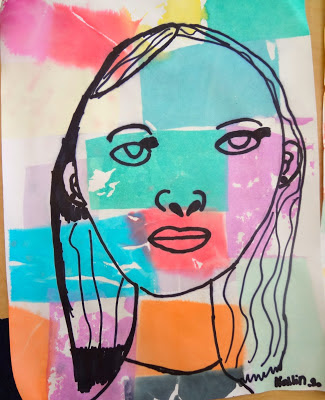Art Teachers loooove to do self portraits with kids. This was a cool twist on the self portrait AND it involves art appreciation AND is much easier to clean up and set up than paint. Perfect! Read on if you wanna do it too.
You will need:
- white paper (duh)
- sharpies
- newspapers or something to protect desks from said sharpies
- bleeding art tissue paper, cut into small squares (craft stores)
- 1 or 2 spray bottle(s)
Lesson:
1.) Introduce Paul Klee...show slideshow of his work (especially ones with the colored squares). Talk about how he was very interested in color theory - how colors relate to other colors around them. Ask kids to describe some of his paintings or share what they observed.
2.) Show how to draw a face in correct proportions. Have kids follow along with you as you draw on the board. They will draw all their guide lines in pencil. I learned about proportions of the face back in middle school and it's stuck with me. Here's a great, simple guide.
3.) Once they have their guidelines, students trace over ONLY their features and add details in sharpie. Make sure they're not tracing their guide lines. They don't really need to erase their pencil lines, because once the paper gets wet, they disappear. Emphasize that all the details unique to them will be what makes their portrait look like them: freckles, how they part their hair, face shape, etc.
4.) Pass out tissue squares and have them lay them all out how they want them, thinking about Paul Klee and his experiments with color relationships. Go around and spray each piece with water once kids have them all laid out. After a couple minutes, take off tissue paper and let dry. So cute, right??
These were done by 3rd graders:

















